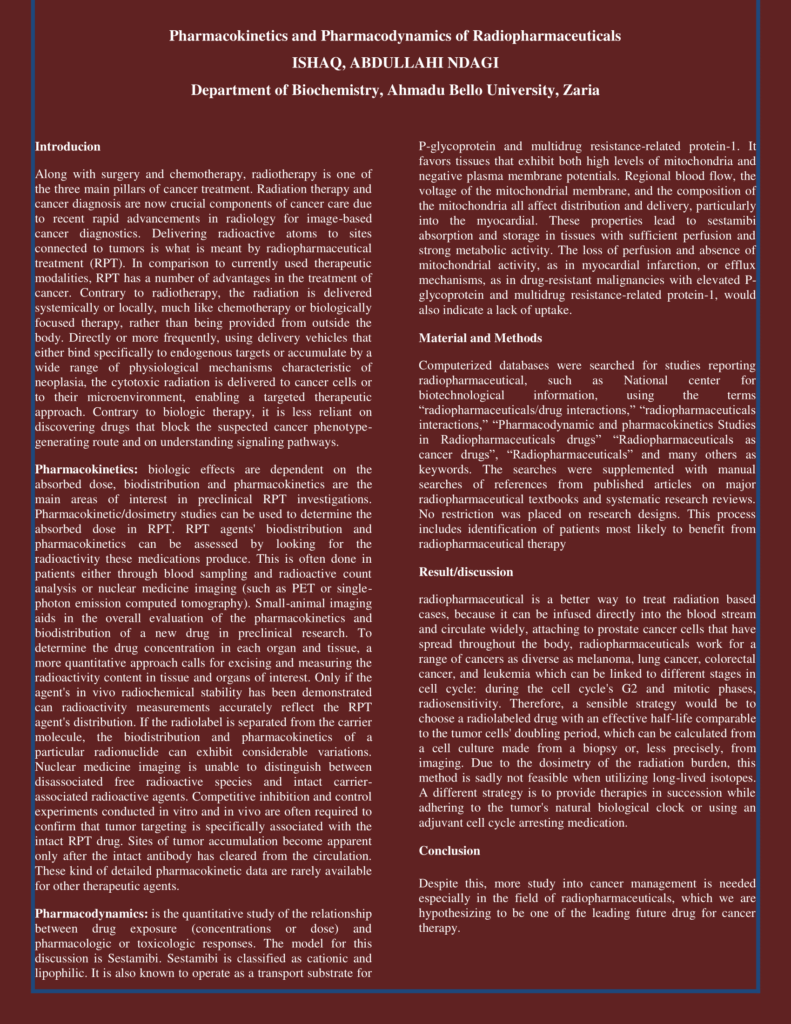Abdullahi Ndagi Ishaq
Conference 2023 Presentation
Project title
Pharmacokinetics and pharmacodynamics of radiopharmaceuticals
Authors and Affiliations
ISHAQ ABDULLAHI NDAGI
Abstract
Background
Along with surgery and chemotherapy, radiotherapy is one of the three main pillars of cancer treatment. Radiation therapy and cancer diagnosis are now crucial components of cancer care due to recent rapid advancements in radiology for image-based cancer diagnostics. Delivering radioactive atoms to sites connected to tumors is what is meant by radiopharmaceutical treatment (RPT). In comparison to currently used therapeutic modalities, RPT has a number of advantages in the treatment of cancer. Contrary to radiotherapy, the radiation is delivered systemically or locally, much like chemotherapy or biologically focused therapy, rather than being provided from outside the body. Directly or more frequently, using delivery vehicles that either bind specifically to endogenous targets or accumulate by a wide range of physiological mechanisms characteristic of neoplasia, the cytotoxic radiation is delivered to cancer cells or to their microenvironment, enabling a targeted therapeutic approach. Contrary to biologic therapy, it is less reliant on discovering drugs that block the suspected cancer phenotype-generating route and on understanding signaling pathways.
Methods
Computerized databases were searched for studies reporting radiopharmaceutical, such as National center for biotechnological information, using the terms “radiopharmaceuticals/drug interactions,” “radiopharmaceuticals interactions,” “Pharmacodynamic and pharmacokinetics Studies in Radiopharmaceuticals drugs” “Radiopharmaceuticals as cancer drugs”, “Radiopharmaceuticals” and many others as keywords. The searches were supplemented with manual searches of references from published articles on major radiopharmaceutical textbooks and systematic research reviews. No restriction was placed on research designs. This process includes identification of patients most likely to benefit from radiopharmaceutical therapy
Results
Radiopharmaceutical is a better way to treat radiation based cases, because it can be infused directly into the blood stream and circulate widely, attaching to prostate cancer cells that have spread throughout the body, radiopharmaceuticals work for a range of cancers as diverse as melanoma, lung cancer, colorectal cancer, and leukemia which can be linked to different stages in cell cycle: during the cell cycle’s G2 and mitotic phases, radiosensitivity. Therefore, a sensible strategy would be to choose a radiolabeled drug with an effective half-life comparable to the tumor cells’ doubling period, which can be calculated from a cell culture made from a biopsy or, less precisely, from imaging. Due to the dosimetry of the radiation burden, this method is sadly not feasible when utilizing long-lived isotopes. A different strategy is to provide therapies in succession while adhering to the tumor’s natural biological clock or using an adjuvant cell cycle arresting medication.
Conclusions
This review unveiled a gap between the old effort of radiopharmaceutical research and new approaches which call for more effort on R&D.

